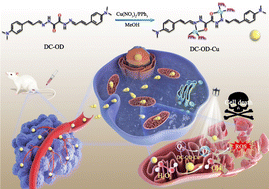A Cu(i)-based Fenton-like agent inducing mitochondrial damage for photo-assisted enhanced chemodynamic therapy†
Abstract
Increasing the reactive oxygen species (ROS) content at the tumor site is one of the effective strategies to promote intracellular oxidative stress and improve therapeutic efficiency. Herein, an atomically precise cinnamaldehyde-derived metal–organic Cu(I) complex (denoted as DC-OD-Cu) was rationally constructed. DC-OD-Cu could preferentially accumulate in the mitochondria of HeLa cells due to the mitochondria-targeting ability of triphenylphosphine, which was accompanied by the generation of large amounts of highly toxic hydroxyl radicals (˙OH) via Cu(I)-mediated Fenton-like reactions. Meanwhile, greater ROS generation jointly results in mitochondrial damage under white LED light irradiation. Furthermore, the in vitro and in vivo results suggested that DC-OD-Cu possesses favorable cytotoxicity and inhibits tumor growth. We believe that this research might provide a controllable strategy to construct multifunctional metal organic complexes for ROS-involved CDT.



 Please wait while we load your content...
Please wait while we load your content...